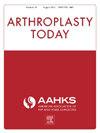脱位的双活动髋关节植入物不太可能成功闭合复位,并且比标准关节植入物更有可能需要翻修
IF 2.1
Q3 ORTHOPEDICS
引用次数: 0
摘要
双活动脱位(DM)全髋关节置换术的自然历史尚不清楚,特别是与标准关节(SAs)相比,闭合复位成功率和翻修率。本研究比较了脱位DM和SA髋的闭合复位成功率和随后的再手术率。方法采用国际疾病分类第十版代码对大型卫生系统中脱位全髋关节置换术患者进行回顾性分析。纳入需要尝试闭合复位。根据种植体类型(DM vs SA)对患者进行分层。收集的数据包括人口统计学、既往手术、复位尝试、假体内游离(IPD)、随后的不稳定和翻修手术。比较两组间的结果。结果74例患者符合纳入标准(糖尿病26例,SA 48例)。DM组闭合复位成功率明显低于SA组(34.6% vs 90%; P < 0.001)。在26例脱位的糖尿病髋中,15例发生IPD,其中5例最初未发生IPD。与SA组相比,DM组的翻修手术更频繁(79.2% vs 53.4%; P < 0.004)。在最初成功闭合复位的患者中,复发性不稳定需要翻修手术的比例没有显著差异(DM 44.4% vs SA 41.9%; P = 0.84)。结论与SA假体相比,脱位DM假体成功闭合复位的可能性更低,需要翻修手术的可能性更大,这主要是由于IPD的高发生率。错过IPD大大增加了再手术的风险,并强调了脱位后准确诊断的重要性。本文章由计算机程序翻译,如有差异,请以英文原文为准。
Dislocated Dual-Mobility Hip Implants Are Unlikely to Be Successfully Closed Reduced and Are More Likely to Require Revision Than Standard Articulation Implants
Background
The natural history of dislocated dual-mobility (DM) total hip arthroplasties remains unclear, particularly regarding closed reduction success and revision rates compared to standard articulations (SAs). This study compared closed reduction success and subsequent reoperation rates between dislocated DM and SA hips.
Methods
A retrospective review was conducted across a large health system, identifying patients with dislocated total hip arthroplasties using International Classification of Disease, Tenth Revision codes. Inclusion required an attempted closed reduction. Patients were stratified by implant type (DM vs SA). Data collected included demographics, prior surgeries, reduction attempts, intraprosthetic dissociation (IPD), subsequent instability, and revision surgery. Outcomes were compared between groups.
Results
Seventy-four patients met the inclusion criteria (26 DM, 48 SA). Successful closed reduction was significantly lower in the DM vs SA group (34.6% vs 90%; P < .001). Among the 26 dislocated DM hips, 15 experienced IPD, including five initially missed. Revision surgery was more frequent in the DM group compared to SA (79.2% vs 53.4%; P < .004). Among those with initially successful closed reductions, rates of recurrent instability requiring revision surgery did not differ significantly (DM 44.4% vs SA 41.9%; P = .84).
Conclusions
Dislocated DM implants are significantly less likely to be successfully closed reduced and more likely to require revision surgery than SA implants, largely due to the high rate of IPD. Missed IPD contributes substantially to the increased reoperation risk and highlights the importance of accurate diagnosis following dislocation.
求助全文
通过发布文献求助,成功后即可免费获取论文全文。
去求助
来源期刊

Arthroplasty Today
Medicine-Surgery
CiteScore
2.90
自引率
0.00%
发文量
258
审稿时长
40 weeks
期刊介绍:
Arthroplasty Today is a companion journal to the Journal of Arthroplasty. The journal Arthroplasty Today brings together the clinical and scientific foundations for joint replacement of the hip and knee in an open-access, online format. Arthroplasty Today solicits manuscripts of the highest quality from all areas of scientific endeavor that relate to joint replacement or the treatment of its complications, including those dealing with patient outcomes, economic and policy issues, prosthetic design, biomechanics, biomaterials, and biologic response to arthroplasty. The journal focuses on case reports. It is the purpose of Arthroplasty Today to present material to practicing orthopaedic surgeons that will keep them abreast of developments in the field, prove useful in the care of patients, and aid in understanding the scientific foundation of this subspecialty area of joint replacement. The international members of the Editorial Board provide a worldwide perspective for the journal''s area of interest. Their participation ensures that each issue of Arthroplasty Today provides the reader with timely, peer-reviewed articles of the highest quality.
 求助内容:
求助内容: 应助结果提醒方式:
应助结果提醒方式:


